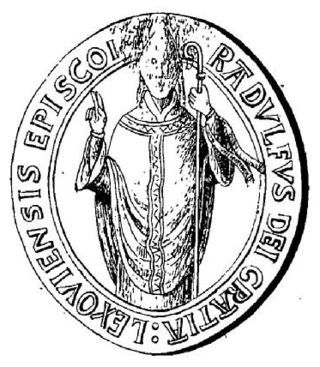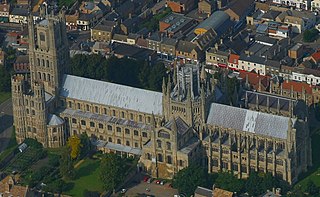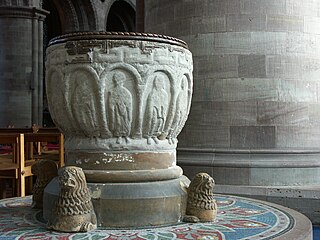Related Research Articles
John de Gray or de Grey was an English prelate who served as Bishop of Norwich, and was elected but unconfirmed Archbishop of Canterbury. He was employed in the service of Prince John even before John became king, for which he was rewarded with a number of ecclesiastical offices, culminating in his pro forma election to Norwich in 1200. De Gray continued in royal service after his elevation to the episcopate, lending the King money and undertaking diplomatic missions on his behalf. In 1205 King John attempted to further reward de Gray with a translation to the archbishopric of Canterbury, but a disputed election process led to de Gray's selection being quashed by Pope Innocent III in 1206.
Ralph d'Escures was a medieval abbot of Séez, bishop of Rochester, and then archbishop of Canterbury. He studied at the school at the Abbey of Bec. In 1079 he entered the abbey of St Martin at Séez and became abbot there in 1091. He was a friend of both Archbishop Anselm of Canterbury and Bishop Gundulf of Rochester, whose see, or bishopric, he took over on Gundulf's death.
Thurstan or Turstin of Bayeux was a medieval Archbishop of York, the son of a priest. He served kings William II and Henry I of England before his election to the see of York in 1114. Once elected, his consecration was delayed for five years while he fought attempts by the Archbishop of Canterbury to assert primacy over York. Eventually, he was consecrated by the pope instead and allowed to return to England. While archbishop, he secured two new suffragan bishops for his province. When Henry I died, Thurstan supported Henry's nephew Stephen of Blois as king. Thurstan also defended the northern part of England from invasion by the Scots, taking a leading part in organising the English forces at the Battle of the Standard (1138). Shortly before his death, Thurstan resigned from his see and took the habit of a Cluniac monk.

Ralph de Warneville was the twentieth Lord Chancellor of England as well as later Bishop of Lisieux in Normandy.
Eustace was the twenty-third Lord Chancellor of England, from 1197 to 1198. He was also Dean of Salisbury and Bishop of Ely.

Walter de Coutances was a medieval Anglo-Norman bishop of Lincoln and archbishop of Rouen. He began his royal service in the government of Henry II, serving as a vice-chancellor. He also accumulated a number of ecclesiastical offices, becoming successively canon of Rouen Cathedral, treasurer of Rouen, and archdeacon of Oxford. King Henry sent him on a number of diplomatic missions and finally rewarded him with the bishopric of Lincoln in 1183. He did not remain there long, for he was translated to Rouen in late 1184.
Hugh de Puiset was a medieval Bishop of Durham and Chief Justiciar of England under King Richard I. He was the nephew of King Stephen of England and Henry of Blois, who both assisted Hugh's ecclesiastical career. He held the office of treasurer of York for a number of years, which led him into conflict with Henry Murdac, Archbishop of York. In 1153, Hugh was elected bishop of Durham despite the opposition of Murdac.
Philip of Poitou was Bishop of Durham from 1197 to 1208, and prior to this Archdeacon of Canterbury.

Roger de Pont L'Évêque was Archbishop of York from 1154 to 1181. Born in Normandy, he preceded Thomas Becket as Archdeacon of Canterbury, and together with Becket served Theobald of Bec while Theobald was Archbishop of Canterbury. While in Theobald's service, Roger was alleged to have committed a crime which Becket helped to cover up. Roger succeeded William FitzHerbert as archbishop in 1154, and while at York rebuilt York Minster, which had been damaged by fire.
Henry Murdac was abbot of Fountains Abbey and Archbishop of York in medieval England.

Reginald Fitz Jocelin was a medieval Bishop of Bath and an Archbishop of Canterbury-elect in England. A member of an Anglo-Norman noble family, he was the son of a bishop, and was educated in Italy. He was a household clerk for Thomas Becket, but by 1167 he was serving King Henry II of England. He was also a favourite of King Louis VII of France, who had him appointed abbot of the Abbey of Corbeil. After Reginald angered Becket while attempting to help negotiate a settlement between Becket and the king, Becket called him "that offspring of fornication, that enemy to the peace of the Church, that traitor." When he was elected as a bishop, the election was challenged by King Henry's eldest son, Henry the Young King, and Reginald was forced to go to Rome to be confirmed by Pope Alexander III. He attended the Third Lateran Council in 1179, and spent much of his time administering his diocese. He was elected Archbishop of Canterbury in 1191, but died before he could be installed.

Hervey le Breton was a Breton cleric who became Bishop of Bangor in Wales and later Bishop of Ely in England. Appointed to Bangor by King William II of England, when the Normans were advancing into Wales, Hervey was unable to remain in his diocese when the Welsh began to drive the Normans back from their recent conquests. Hervey's behaviour towards the Welsh seems to have contributed to his expulsion from his see. Although the new king, Henry I wished to translate Hervey to the see of Lisieux in Normandy, it was unsuccessful.
Savaric fitzGeldewin was an Englishman who became Bishop of Bath and Glastonbury in England. Related to his predecessor as well as to Emperor Henry VI, he was elected bishop on the insistence of his predecessor, who urged his election on the cathedral chapter of Bath. While bishop, Savaric spent many years attempting to annexe Glastonbury Abbey as part of his bishopric. Savaric also worked to secure the release of King Richard I of England from captivity, when the king was held by Emperor Henry VI.
Geoffrey de Burgh was a medieval English cleric who was Archdeacon of Norwich (1200–1225), Bishop of Ely and the brother of William de Burgh and Hubert de Burgh, 1st Earl of Kent.
John of Tours or John de Villula (died 1122) was a medieval Bishop of Wells in England who moved the diocese seat to Bath. He was a native of Tours and was King William I of England's doctor before becoming a bishop. After his consecration as bishop, he was either given or purchased Bath Abbey, a rich monastery, and then moved the headquarters of the diocese from Wells, to the abbey. He rebuilt the church at Bath, building a large cathedral that no longer survives. He gave a large library to his cathedral and received the right to hold a fair in Bath. Not noted for his scholarship, he died suddenly in 1122.
Simon Langton was an English medieval clergyman who served as Archdeacon of Canterbury from 1227 until his death in 1248. He had previously been Archbishop-elect of York, but the election was quashed by Pope Innocent III.

Robert Foliot was a medieval Bishop of Hereford in England. He was a relative of a number of English ecclesiastics, including Gilbert Foliot, one of his predecessors at Hereford. After serving Alexander, Bishop of Lincoln as a clerk, he became a clerk of Henry of Blois, the Bishop of Winchester and brother of King Stephen of England. He attended the Council of Reims in 1148, where another relative, Robert de Chesney, was elected as Bishop of Hereford. Chesney then secured the office of Archdeacon of Oxford for Foliot.
Robert de Chesney was a medieval English Bishop of Lincoln. He was the brother of an important royal official, William de Chesney, and the uncle of Gilbert Foliot, successively Bishop of Hereford and Bishop of London. Educated at Oxford or Paris, Chesney was Archdeacon of Leicester before his election as bishop in December 1148.
William Cumin was a bishop of Durham, and Justiciar of Scotland.

Richard Barre was a medieval English justice, clergyman and scholar. He was educated at the law school of Bologna and entered royal service under King Henry II of England, later working for Henry's son and successor Richard I. He was also briefly in the household of Henry's son Henry the Young King. Barre served the elder Henry as a diplomat and was involved in a minor way with the king's quarrel with Thomas Becket, which earned Barre a condemnation from Becket. After King Henry's death, Barre became a royal justice during Richard's reign and was one of the main judges in the period from 1194 to 1199. After disagreeing with him earlier in his career, Barre was discharged from his judgeship during John's reign as king. Barre was also archdeacon of Ely and the author of a work of biblical extracts dedicated to one of his patrons, William Longchamp, the Bishop of Ely and Chancellor of England.
References
- Barlow, Frank (1979). The English Church 1066–1154: A History of the Anglo-Norman Church. New York: Longman. ISBN 0-582-50236-5.
- Bartlett, Robert C. (2000). England Under the Norman and Angevin Kings: 1075–1225. Oxford, UK: Clarendon Press. ISBN 0-19-822741-8.
- Duggan, A. J. (2004). "Ridel, Geoffrey (d. 1189)". Oxford Dictionary of National Biography. Oxford University Press. doi:10.1093/ref:odnb/23618 . Retrieved 8 March 2008.(subscription or UK public library membership required)
- Fryde, E. B.; Greenway, D. E.; Porter, S.; Roy, I. (1996). Handbook of British Chronology (Third revised ed.). Cambridge, UK: Cambridge University Press. ISBN 0-521-56350-X.
- Gillingham, John (1999). Richard I. New Haven, CT: Yale University Press. ISBN 0-300-07912-5.
- Greenway, Diana E. (1971). "Canterbury: Archdeacons of Canterbury". Fasti Ecclesiae Anglicanae 1066–1300. Vol. 2: Monastic Cathedrals (Northern and Southern Provinces). Institute of Historical Research. Archived from the original on 16 June 2009. Retrieved 25 October 2007.
- Greenway, Diana E. (1971). "Ely: Bishops". Fasti Ecclesiae Anglicanae 1066–1300. Vol. 2: Monastic Cathedrals (Northern and Southern Provinces). Institute of Historical Research. Archived from the original on 14 February 2012. Retrieved 25 October 2007.
- Huscroft, Huscroft (2005). Ruling England 1042–1217. London: Pearson/Longman. ISBN 0-582-84882-2.
- Knowles, M. D.; Duggan, Anne J.; Brooke, C. N. L. (October 1972). "Henry II's Supplement to the Constitutions of Clarendon". The English Historical Review . 87 (345): 757–771. doi:10.1093/ehr/LXXXVII.CCCXLV.757. JSTOR 562200.
- Poole, Austin Lane (1955). From Domesday Book to Magna Carta, 1087–1216 (Second ed.). Oxford, UK: Clarendon Press. OCLC 233685139.
- Turner, Ralph V. (Spring 1986). "Religious Patronage of Angevin Royal Administrators, c. 1170–1239". Albion . 18 (1): 1–21. doi:10.2307/4048700. JSTOR 4048700.
- Warren, W. L. (1973). Henry II. Berkeley, CA: University of California Press. OCLC 4274479.